Carrier interferometry

Have you ever played with two waves, like the waves in the ocean or the waves in a pool? Imagine that you have two friends, and they are both going to make waves in the pool. One friend will make big waves by splashing really hard, and the other friend will make small waves by simply wiggling their fingers. If you stand in the pool between your friends, you will feel the big waves push you around a lot, but you might not feel the small waves as much.
Now, let's talk about carrier interferometry. Just like your friends were making waves, in carrier interferometry we have light waves. A carrier wave is a specific type of light wave, and it's used to carry information. It's like a special messenger that brings a message from one place to another.
When we want to send a message using light, we add a signal wave to the carrier wave. This signal wave is like the message that we want to send. When the carrier and signal waves are combined, they create a new wave that has information in it.
Now, sometimes the carrier wave and signal wave can get mixed up and cross paths with each other. This is where carrier interferometry comes in. It's like if your two friends made waves that collided with each other. The big waves might overpower the small waves, or they might combine together to make even bigger waves.
In carrier interferometry, we use special tools to measure the interference between the carrier and signal waves. We can use this interference to detect different things, like how fast something is moving or how far away it is. It's like if you stood in the pool and felt the waves from your friends colliding with each other. You could use that information to tell which friend was making the big waves and which friend was making the small waves.
So, carrier interferometry is all about how light waves can be combined together to carry information, and how we can use the interference between those waves to detect things in the world around us.
Now, let's talk about carrier interferometry. Just like your friends were making waves, in carrier interferometry we have light waves. A carrier wave is a specific type of light wave, and it's used to carry information. It's like a special messenger that brings a message from one place to another.
When we want to send a message using light, we add a signal wave to the carrier wave. This signal wave is like the message that we want to send. When the carrier and signal waves are combined, they create a new wave that has information in it.
Now, sometimes the carrier wave and signal wave can get mixed up and cross paths with each other. This is where carrier interferometry comes in. It's like if your two friends made waves that collided with each other. The big waves might overpower the small waves, or they might combine together to make even bigger waves.
In carrier interferometry, we use special tools to measure the interference between the carrier and signal waves. We can use this interference to detect different things, like how fast something is moving or how far away it is. It's like if you stood in the pool and felt the waves from your friends colliding with each other. You could use that information to tell which friend was making the big waves and which friend was making the small waves.
So, carrier interferometry is all about how light waves can be combined together to carry information, and how we can use the interference between those waves to detect things in the world around us.
Related topics others have asked about:
